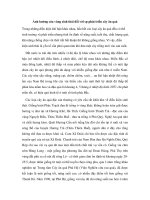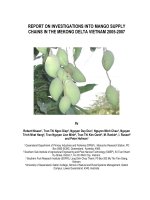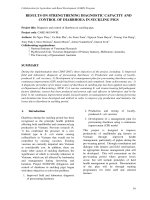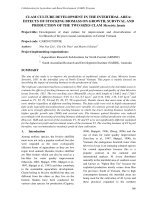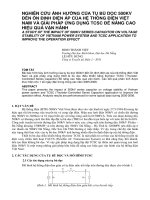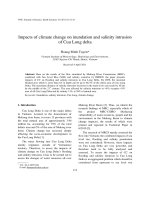Báo cáo nghiên cứu khoa học: "STUDY ON THE ANTIBACTERIAN CHARACTERISTICS OF TEA TREE OIL AND ITS APPLICATION IN COSMETICS" ppt
Bạn đang xem bản rút gọn của tài liệu. Xem và tải ngay bản đầy đủ của tài liệu tại đây (474.17 KB, 9 trang )
TẠP CHÍ PHÁT TRIỂN KH&CN, TẬP 11, SỐ 08 - 2008
Trang 105
STUDY ON THE ANTIBACTERIAN CHARACTERISTICS OF TEA TREE
OIL AND ITS APPLICATION IN COSMETICS
Phan Dinh Tuan, Hoang Minh Nam, Nguyen Thi Thanh Nga
University of Technology, VNU-HCM
(Manuscript Received on January 10
th
, 2008, Manuscript Revised May 12
th
, 2008)
ABSTRACT: The article describes the investigation results on the antibacterial activity
of the Australian-originated tea tree (Alternifolia melaleuca) oil and its application in
cosmetics production. The research points out that not only terpinen-4-ol but also other
components of the oil have rather high antibacterial activity. With a dose of about 0.25%, all
fractions of the tea tree oil could destroy 90% the typical bacteria as Escherichia coli,
Staphylococcus aureus, Pseudomonas aeruginosa and Candida albacans. A test of adding
0.25% of the oil into cosmetics shows that the product retains its antibacterial activity and
pleasant odor as well. The investigation results contribute to its application prospect in
producing detergents, cosmetics and pharmaceuticals of suitable antibacterial activity.
Keyword: Tea tree oil; terpinen 4-ol; antibacterial;
1.INTRODUCTION
Tea trees have been widely planted in the Mekong River Delta area of Vietnam. The
investigation has pointed out that its essential oil composition is of about 2% by weight. The
essential oil could be easily recovered and purified by steam distillation followed by fractional
one [9].
It has been reported that tea tree oil has rather high antibacterial activity [9,12,14,17,18]
for its high composition of terpinen-4-ol. Nevertheless, it has been found that not only
terpinen-4-ol but also other components have the activity. It is necessary to find out the
available minimum dose of the essential oil in practical use that the antibacterial activity could
be retained. Besides, it is important to point out the available ability to use different fractions
of the essential oil for antibacterial purpose.
2.MATERIALS AND METHODS
2.1.Materials
The original tea tree essential oil is recovered and fractionally distillated from the tea trees
planted in the Mekong River Delta area of Vietnam. From these fractions, initial essential oil
has been prepared by simple mixing the fractions of 0% and 98% terpinen-4-ol to receive the
mixtures of about 25%, 50%, 75% and 90% terpinen-4-ol.
2.2.Microorganisms
Escherichia coli and Staphylococcus aureus microorganisms are supplied by the
Department of Biotechnology of Hochiminh City University of Technology. Pseudomonas
aeruginosa and Candida albicans are supplied by the Pasteur Institute at Hochiminh City.
2.3.Methodology
Antibacterial activity of the essential oil, its distilled fractions or of essential oil based
cosmetics are determined by the method of diffusion well (hole boring) and the method of
microorganism counting. In the case of cosmetic products, the method of microorganism
Science & Technology Development, Vol 11, No.08 - 2008
Trang 106
counting is applied, provided that the water-undissolved essential oil is emulsified by Tween
80 as the emulsifying reagent.
3.RESULTS AND DISCUSSION
3.1.Qualitative investigation of antibacterial activity by diffusion well method
The hole boring method is applied to all types of chosen microorganisms. The
concentrations of the used essential oil fractions are represented by the number of microlitters
applied to the hole. The investigated results are shown on Figures 1a, 1b, 1c, 1d for
Escherichia coli, Staphylococcus aureus, Candida albacans and Pseudomonas aeruginosa,
respectively.
Checking the effect of essential oil evaporation by contacting the agar medium with the
essential oil vapor is shown in Table 1. It has pointed out that only the diffusion of the oil
determines the antibacterial characteristics.
It is pointed out from the experimental results that at lower concentration of essential oil,
diameters of the antibacterial cycles rapidly increase with its used amounts. At higher
concentration of essential oil, the diameters increase also but more slowly. It has the reason of
non-polar nature of the essential oil, so that its diffusion in polar water at higher concentration
is more difficult.
By the way, diameters of the antibacterial cycles increase with the concentration of
terpinen-4-ol in the essential oil, with the exception of Staphylococcus aureus and
Pseudomonas aeruginosa at very high (98%) concentration of terpinen-4-ol. It may be caused
by the less composition of other components in the essential oil and the different cell structures
of different types of bacteria.
3.2.Quantitative investigation of antibacterial activity by microorganism counting
method
To quantitatively investigate the antibacterial activity of different concentrations of
essential oil, microorganism counting method has been applied. Three concentrations (0.5%,
0.25% and 0.1% v/v) have been tested to every chosen type of bacterium. The results are
shown in Tables 2,3,4,5 for Escherichia coli, Staphylococcus aureus, Candida albicans and
Pseudomonas aeruginosa, respectively.
It is clear from experimental results that with 0.5% and 0.25% v/v, all fractions of the
essential oil have the antibacterial efficiency of about 90%, including of the fraction of 98%
terpinen-4-ol to all chosen types of bacteria, except the little lower efficiency for the case of
Pseudomonas aeruginosa. This means that the method in more quantitative than the hole
boring method, where the non-polar essential oil is less diffusive in polar water media.
With the concentration of 0.1% v/v, the antibacterial effect is still rather high to
Escherichia coli (more than 80%), Staphylococcus aureus (more than 85%) and Candida
albican (more than 90%). The high antibacterial activity of the fractions of lower terpinen-4-ol
composition points out that beside terpinen-4-ol, other components in the tea tree oil have also
the added effect of antibacterium.
3.3.Investigation of tea tree oil application in cosmetics
Since tea tree oil is not dissolved in water, the emulsifying reagent Tween-80 is applied
with the concentration of 1%. Two concentrations of essential oil have been used: 0.25% and
0.1%. The tests have been carried out to body soap and shampoo. Investigation results are
shown in Tables 6,7,8,9.
TẠP CHÍ PHÁT TRIỂN KH&CN, TẬP 11, SỐ 08 - 2008
Trang 107
It has been shown that with only 0.1% of the essential oil, the product is kept with pleasant
odor and no colour-change.
4.CONCLUSION
Through the experimental results, it could be pointed out:
- Tea tree oil has strong antibacterial activity to Escherichia coli, Staphylococcus aureus
and Candida albacans, and a little weaker to Pseudomonas aeruginosa.
- The more concentration of terpinen-4-ol in the essential oil is, the more effective its
antibacterial activity is. Nevertheless, not only terpinen-4-ol but also other components in the
tea tree oil have the antibacterial effect.
- The accepted dose of all fractions of the tea tree oil in practical use is 0.25%.
- By adding 1% of the emulsifying reagent Tween-80, 0.25% of the tea tree oil could be
applied in the cosmetic production for antibacterial purpose.
9
11
13
15
17
19
21
23
25
27
29
31
33
35
0 5 10 15 20 25 30 35 40 45 50 55 60 65 70 75 80 8
5
Hàm lïng tinh dầu(ml)
Đường kính vò ng vô khuẩn (mm)
PD terpinen-4-ol 25%
Tinh Dầu ban đầu
PĐ Terpinen-4-ol 50%
PĐ Terpinen-4-ol 75%
PĐ tepinen-4-ol 90%
PĐ Terpinen-4-ol 98%
Gentamixin
10
12
14
16
18
20
22
24
26
28
30
32
34
36
38
0 5 10 15 20 25 30 35 40 45 50 55 60 65 70 75 80 85
Hàm lượng tinh dầu (μl)
Đường kính vòng vô khuẩn(mm)
tinh dầu ban đầu
PĐ terpinen-4-ol 25%
PĐ terpinen-4-ol-50
PĐ terpinen-4-ol 75%
PĐ terpinen-4-ol 90%
PD terpinen-4-ol >98
Gentamixin
a) b)
6
8
10
12
14
16
18
20
22
24
26
28
30
32
0 5 10 15 20 25 30 35 40 45 50 55 60 65 70 75 80 85
Hàm lượng tinh dầu(
μ
l)
Đường kính vòng vô khuẩn (mm)
tinh dầu ban đầu
PD terpinen-4-ol 25%
PD terpinen-4-ol 50%
PD terpinen-4-ol 75%
PD terpinen-4-ol 90%
PD terpinen-4-ol >98%
Gentamixin
5
10
15
20
25
30
35
0 5 10 15 20 25 30 35 40 45 50 55 60 65 70 75 80 85
Hàm lượng tinh dầu (
μ
l)
Đường kính vòng vô khuẩn (mm)
tinh dau ban đầu
PD terpinen 4-ol 25%
PD terpinen-4-ol 50%
PD terpinen-4-ol 75%
PD terpinen-4-ol 90%
PD terpinen-4-ol 98%
Gentamixin
c) d)
Figure 1. Dependence of the antibacterial cycle diameter on the used amount of essential oil
a) Escherichia coli, b) Staphylococcus aureus, c) Candida albicans, d) Pseudomonas aeruginosa
Table 1. Antibacterial effect of essential oil diffusion and evaporation
Diffusion only Evaporation only Both diffusion and
evaporation
Used amount of
essential oil (µl)
Diameter of the antibacterial cycle (mm)
25
19 7 19
25 19 7 19
25
19 7 19
Average
Science & Technology Development, Vol 11, No.08 - 2008
Trang 108
25
19 7 19
Table 2. Investigation result for antibacterial activity to Escherichia coli
Sample Concentration
(v/v)
Bacterium
before contact
(cfu/ml)
Alive bacterium
(cfu/ml)
Percentage of
killed bacteria
(%)
0.1 5.10
6
882.000 83.3
0.25 5.10
6
640.000 87.2
Original
essential oil
0.5 5.10
6
375.000 92.5
0.1 5.10
6
744.000 80.4
0.25 5.10
6
800.000 78.9
Fraction of 25%
Terpinen-4-ol
0.5 5.10
6
546.000 85.6
0.1 5.10
6
594.000 84.4
0.25 5.10
6
480.000 87.4
Fraction of 50%
Terpinen-4-ol
0.5 5.10
6
276.000 92.7
0.1 3.8.10
6
516.000 86.4
0.25 3.8.10
6
468.000 87.7
Fraction of 75%
Terpinen-4-ol
0.5 3.8.10
6
246.000 93.5
0.1 3.8.10
6
450.000 88.2
0.25 3.8.10
6
392.000 89.7
Fraction of 90%
Terpinen-4-ol
0.5 5.6.10
6
351.000 93.7
0.1 5.6.10
6
648.000 88.4
0.25 5.6.10
6
396.000 92.9
Fraction of 98%
Terpinen-4-ol
0.5 5.6.10
6
333.000 94.1
Table 3. Investigation result for antibacterial activity to Staphylococcus aureus
Sample Concentration
(v/v)
Bacterium before
contact (cfu/ml)
Alive bacterium
(cfu/ml)
Percentage of
killed bacteria
(%)
0.1 3.02.10
7
2.160.000 92.8
0.25 3.02.10
7
1.383.000 95.4
Original
essential oil
0.5 3.02.10
7
826.000 97.3
0.1 1.62.10
7
2.032.000 87.5
0.25 1.62.10
7
549.000 96.6
Fraction of
25%
Terpinen-4-ol
0.5 1.62.10
7
350.000 97.8
0.1 1.62.10
7
231.600 85.7
0.25 1.62.10
7
504.000 96.9
Fraction of
50%
Terpinen-4-ol
0.5 1.62.10
7
312.000 98.1
Fraction of 0.1 8.8.10
6
795.000 91.0
TẠP CHÍ PHÁT TRIỂN KH&CN, TẬP 11, SỐ 08 - 2008
Trang 109
0.25 8.8.10
6
729.000 91.7
75%
Terpinen-4-ol
0.5 8.8.10
6
454.000 94.8
0.1 8.8.10
6
1.450.000 83.5
0.25 8.8.10
6
795.000 91.0
Fraction of
90%
Terpinen-4-ol
0.5 8.8.10
6
382.000 95.7
0.1 3.02.10
7
2.630.000 91.3
0.25 3.02.10
7
2.240.000 92.6
Fraction of
98%
Terpinen-4-ol
0.5 3.02.10
7
1.130.000 96.3
Table 4. Investigation result for antibacterial activity to Pseudomonas aeruginosa
Sample Concentration
(v/v)
Bacterium
before contact
(cfu/ml)
Alive bacterium
(cfu/ml)
Percentage of
killed
bacteria (%)
0.1 2.32.10
7
7.080.000 69.5
0.25 2.32.10
7
3.300.000 85.8
Original
essential oil
0.5 2.32.10
7
3.024.000 87.0
0.1 2.32.10
7
4.920.000 78.8
0.25 2.32.10
7
2.120.000 90.9
Fraction of 25%
Terpinen-4-ol
0.5 2.32.10
7
1.085.000 95.3
0.1 2.32.10
7
5.784.000 75.1
0.25 2.32.10
7
3.140.000 86.5
Fraction of 50%
Terpinen-4-ol
0.5 2.32.10
7
1.764.000 92.4
0.1 2.32.10
7
5.760.000 75.7
0.25 2.32.10
7
3.220.000 86.1
Fraction of 75%
Terpinen-4-ol
0.5 2.32.10
7
1.764.000 92.4
0.1 1.12.10
7
3.696.000 67.0
0.25 1.12.10
7
3.159.000 71.79
Fraction of 90%
Terpinen-4-ol
0.5 1.12.10
7
1.750.000 84.4
0.1 1.12.10
7
4.074.000 63.6
0.25 1.12.10
7
3.636.000 67.5
Fraction of 98%
Terpinen-4-ol
0.5 1.12.10
7
2.580.000 77.0
Table 5. Investigation result for antibacterial activity to Candida albicans
Sample Concentration
(v/v)
Bacterium
before
contact
(cfu/ml)
Alive bacterium
(cfu/ml)
Percentage of
killed bacteria
(%)
0.1 7.2.10
6
588.000 91.9
0.25 7.2.10
6
500.000 93.1
Original
essential oil
0.5 7.2.10
6
320.000 95.6
0.1 7.2.10
6
720.000 90.0
Fraction of
25%
0.25 7.2.10
6
580.000 91.9
Science & Technology Development, Vol 11, No.08 - 2008
Trang 110
Terpinen-4-ol 0.5 7.2.10
6
224.000 96.9
0.1 7.2.10
6
552.000 92.3
0.25 7.2.10
6
280.000 96.2
Fraction of
50%
Terpinen-4-ol
0.5 7.2.10
6
200.000 97.2
0.1 5.8.10
6
444.000 92.4
0.25 5.8.10
6
330.000 94.3
Fraction of
75%
Terpinen-4-ol
0.5 5.8.10
6
280.000 95.2
0.1 5.8.10
6
396.000 93.2
0.25 5.8.10
6
300.000 94.9
Fraction of
90%
Terpinen-4-ol
0.5 5.8.10
6
240.000 95.9
0.1 1.4.10
7
456.000 96.7
0.25 1.4.10
7
450.000 96.8
Fraction of
98%
Terpinen-4-ol
0.5 1.4.10
7
288.000 98.9
Table 6. Investigation result for antibacterial activity of the essential oil in cosmetics to E.coli
Sample Concentration
(v/v)
Bacterium before
contact (cfu/ml)
Alive bacterium
(cfu/ml)
Percentage of
killed bacteria
(%)
0 3.12.10
7
5.000.000 84.0
0.1 3.12.10
7
1.048.000 96.6
Body soap
0.25 3.12.10
7
4.560.00 98.5
0 3.12.10
7
5.920.000 81.0
0.1 3.12.10
7
1.144.000 96.3
Shampoo
0.25 3.12.10
7
520.000 98.3
Table 7. Investigation result for antibacterial activity of the essential oil in cosmetics to
Staphylococcus aureus
Sample Concentration
(v/v)
Bacterium
before contact
(cfu/ml)
Alive bacterium
(cfu/ml)
Percentage of
killed bacteria
(%)
0 2.24.10
7
5.000.000 77.78
0.1 2.24.10
7
93.000 95.8
Body soap
0.25 2.24.10
7
496.000 97.8
0 2.24.10
7
5.920.000 73.6
0.1 2.24.10
7
456.000 98.0
Shampoo
0.25 2.24.10
7
336.000 98.5
TẠP CHÍ PHÁT TRIỂN KH&CN, TẬP 11, SỐ 08 - 2008
Trang 111
Table 8. Investigation result for antibacterial activity of the essential oil in cosmetics to
Candida albicans
Sample Concentration
(v/v)
Bacterium before
contact (cfu/ml)
Alive bacterium
(cfu/ml)
Percentage of
killed bacteria
(%)
0 6.6.10
6
1.480.000 77.6
0.1 6.6.10
6
420.000 93.6
Body soap
0.25 6.6.10
6
330.000 95.0
0 6.6.10
6
1.560.000 76.4
0.1 6.6.10
6
480.000 92.7
Shampoo
0.25 6.6.10
6
344.000 94.8
Table 9. Investigation result for antibacterial activity of the essential oil in cosmetics to
Pseudomonas aeruginosa
Sample Concentration
(v/v)
Bacterium
before contact
(cfu/ml)
Alive bacterium
(cfu/ml)
Percentage of
killed bacteria
(%)
0 2.8.10
7
6.960.000 75.7
0.1 2.8.10
7
2.808.000 90.2
Body soap
0.25 2.8.10
7
1.152.000 96.0
0 2.8.10
7
7.080.000 75.2
0.1 2.8.10
7
2.832.000 90.1
Shampoo
0.25 2.8.10
7
1.248.000 95.6
NGHIÊN CỨU ĐẶC TÍNH KHÁNG KHUẨN CỦA TINH DẦU TRÀM TRÀ VÀ
KHẢ NĂNG ỨNG DỤNG TRONG MỸ PHẨM
Phan Đình Tuấn, Hoàng Minh Nam, Nguyễn Thị Thanh Nga
Trường Đại Học Bách Khoa, ĐHQG-HCM
TÓM TẮT:Bài báo trình bày các kết quả nghiên cứu về đặc tính kháng khuẩn của tinh
dầu tràm trà giống Úc trồng tại Đồng Tháp Mười của Đồng Bằng Sông Cửu Long và khả
năng sử dụng nó trong sản xuất các mỹ phẩm. Kết quả nghiên cứu chỉ ra rằng không chỉ có
terpinen 4-ol mà các cấu tử khác có mặt trong tinh dầu tràm trà đều có khả năng kháng
khuẩn. Với hàm lượng sử dụng 0,25%, các phân đoạn khác nhau của tinh dầu tràm đều có khả
năng tiêu diệt các chủng Escherichia coli, Staphylococcus aureus, Pseudomonas aeruginosa
và Candida albacans là các chủng điển hình đến 90%. Việc ứng dụng thử nghiệm các phân
Science & Technology Development, Vol 11, No.08 - 2008
Trang 112
đoạn khác nhau của tinh dầu tràm trà trong sản xuất mỹ phẩm cho thấy với hàm lượng
0,25%, hoạt tính kháng khuẩn của tinh dầu luôn được đảm bảo mà vẫn có mùi dễ chịu. Kết
quả này góp phần củng cố triển vọng ứng dụng của tinh dầu tràm trà trong việc sản xuất các
chất tẩy rửa, mỹ phẩm và dược phẩm.
REFERENCES
[1].
Lê Ngọc Thạch, Tinh dầu, NXB Đại Học Quốc Gia Tp Hồ Chí Minh, (2003)
[2].
Vương Ngọc Chính, Hương Liệu Mỹ Phẫm, NXB Đại Học Quốc Gia Tp Hồ Chí
Minh, (2005)
[3].
Nguyễn Đức Lượng, Phan Thị Huyền, Nguyễn Ánh Tuyết, Thí Nghiệm Vi Sinh Vật
học, NXB Đại Học Quốc Gia Tp Hồ Chí Minh, (2006).
[4].
Đỗ Tất Lợi, Những cây thuốc và Vị thuốc Việt Nam, NXB Khoa Học và Kỹ Thuật,
Hà Nội, (1986).
[5]. Đỗ Tất Lợi, Tinh Dầu Việt Nam, NXB Y Học, (1985).
[6].
Vũ Ngọc Lộ và nhiều tác giả, Những cây tinh dầu Việt Nam: Khai Thác, chế biến,
Ứng Dụng, NXB Khoa học và Kỹ thuật, Hà Nội, (1996).
[7]. Nguyễn Lân Dũng, Một số Phương Pháp nghiên cứu vi sinh vật học, Tập II, NXB
Khoa học và Kỹ Thuật, Hà Nội, (1976).
[8].
Louis Hồ Tấn Tài, Các sản phẩm tẩy rửa và chăm sóc cá nhân- Lý thuyết và Ứng
Dụng. Công Ty Liksin, TP HCM, (1999).
[9].
Lê Nhất Thống, Nghiên cứu công nghệ tách thu hồi tinh dầu Tràm Trà giống Úc
(Melaleuca Alternifolia)trồng trên đất phèn Đồng Bằng Sông Cửu Long, Việt Nam,
Luận văn Thạc Sĩ, trường Đại Học Bách Khoa Tp.HCM, (1999)
[10].
The Essential oil, Vol 1,2,3,4, New York, (1982).
[11].
J E Drinnan B.Agar, Development of the North Queensland Tea Tree Industry,
(1998)
[12].
C F Carson, T V Riley, Antimicrobial Activity of Tea Tree Oil, DPIE Copy Centre,
(1998).
[13].
Southwell et all, Quality assurance for Tea Tree Oil safety investigative samples ,
Canprint, (2006).
[14].
C F Carson, T V Riley, Antimicrobial anti-inflammatory of Tea Tree Oil, DPIE Copy
Centre, (2000).
[15].
Jane Southwell et al, Metabolism of 1,8- cineol in Tea Tree (Melaleuca Alternifolia)
by pygo Beetle, (1994).
[16]. Diane M. Martin, Joorg Bohlmann, Phytochemistry 65, (2004), p.1223–1229.
[17].
S.D. Cox et al., The mode of antimicrobial action of the essential oil of Melaleuca
alternifolia (tea tree oil), Journal of Applied Microbiology, (2000), 88, p.170–175.
[18].
K.A. Hammer, C.F. Carson and T.V. Riley, Antifungal activity of the components of
Melaleuca alternifolia (tea tree) oil, Journal of Applied Microbiology, (2003), 95,
p.853–860.
[19].
Shelley F. Walton, Acaricidal Activity of Melaleuca alternifolia (Tea Tree) Oil, Arch
Dermatol/ Vol. 140, May 2004, p.563-567.
TẠP CHÍ PHÁT TRIỂN KH&CN, TẬP 11, SỐ 08 - 2008
Trang 113
[20]. S.D. Cox, C.M. Mann and J.L. Markham, Interactions between components of the
essential oil of Melaleuca alternifolia, Journal of Applied Microbiology (2001),
91,p.492-497.
[21].
Christine F. Carson, Brian J. Mee, and Thomas V. Riley, Mechanism of Action of
Melaleuca alternifolia (Tea Tree) Oil on Staphylococcus aureus, determined by
Time-Kill, Lysis, Leakage, and Salt Tolerance Assays and Electron Microscopy,
Antimicrobial agents and Chemotherapy, June 2002, p.1914–1920.
[22].
S.A. Burt and R.D. Reinders, Antibacterial activity of selected plant essential oils
against Escherichia coli, Letters in Applied Microbiology,(2003), 36, p.162–167.
[23].
J.E Gustafson et al., Effect of tee tree oil on Escherichia coli, Letters in Applied
Microbiology, (1998), 26, p.194-198.

